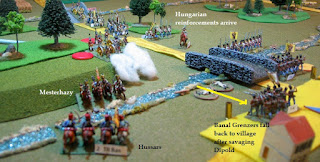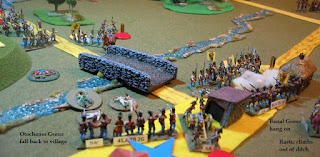Last night the Corlears Hook Fencibles started playing again
after a lengthy vacation break. I chose a small scenario (about the smallest
Bloody Big Battles scenario I’m aware of) that had simple terrain, to ease back
in after a 6 week layoff. I figured we could play it twice in an evening. The
game was the 1849 battle of Tapio-Bicske which sees a Hungarian column attack a
Croat force during the abortive Hungarian Independence War.
Rick commanded the Hungarians while Ken led the Croats. Ken started off with an attack on the lead Hungarian infantry unit in the town.
Cavalry assaulted the Hungarian flank but were shot down and dispersed by
well-served Hungarian artillery.
The Otochaner Grenzers went in with a mighty cheer (a 6 on
the assault die). Dipold’s Hungarian infantry must have been rounding up
livestock or something (they rolled a 1). They were badly beaten and thrown out
of the village. The Grenzers exploited on and caught Bobics’ troops in road
column, beating them badly too. The limbered artillery behind snarled while
attempting to turn around – something about a wheel in a road side ditch (lousy
movement dice). The Grenzers shot them down as the surviving gunners cut the
traces and rode off with whatever horses could still move.
The isolated Grenzers fell back as the second echelon of
Hungarian infantry arrived.
The remaining Croat cavalry spent at least 4 turns marking
time, perhaps impressed by what had happened to their Hussars.
The fresh Hungarian infantry were made of sturdier stuff and
began to fight their way into the village.
The Hungarian cavalry charged, with mixed results.
Mesterhazy and the Dragoons fought each other to oblivion. A
second charge by Kaszonyi’s cavalry forced the Croat battery to withdraw. The
Croats managed to win in slightly over 2 hours (8 turns).
Considering the small numbers of troops, losses were
astounding: Croats lost 3 infantry stands (of 8), 2 cavalry and the remaining 2
run off while the Hungarians lost 5 infantry and 2 run off (out of 16), 2
cavalry and one run off (out of 5) and 1 artillery unit (of 4). We broke for
dinner.
Ken declined to play the second game so Rick decided to
reprise his role as Hungarian commander. I took the Croats: all the photos from
here on are taken from that side of the table. On my first turn I tried to
crush the head of the Hungarian column but was rebuffed.
My dice heated up and the lead Hungarian unit was riddled
with musket fire.
Now I threw in my major effort. My Hussars attacked
Mesterhazy’s cavalry to keep them busy (and negate their zone of control) while
my Dragoons (who look like uhlans) would flank the Hungarian guns on the hill.
I figured they would ride down the first battery and exploit into and ride down
the second one. Instead they narrowly drove off the first one and stopped on
the spot, apparently looting the kit left behind by the gunners.
The second battery pulled up stakes and retreated as the
large Hungarian Hussar unit fell on my Dragoons, dispersing them in a
sanguinary brawl. My Hussars and Mesterhazy fought themselves out.
This did break up the concentration of Hungarian artillery,
though none of them were overrun. It cost all of my cavalry. The second echelon
of enemy infantry came on strong.
A bayonet charge drove the Banal Grenzers back, forcing
Rastic (me!) to leap into a roadside ditch and get some truly foul stuff on my
uniform. However will my attendant get those stains out?
A last turn cavalry charge was shot down by our gunners,
with help from nearby infantry.
We held the village for a win with the same points as the
previous game.
We played the 8 turns in slightly under 2 hours. Again
losses were heavy and nearly the same as the first game. My Croats lost 3
infantry bases, 2 cavalry with the remaining 2 ran off. Hungarian losses were 5
infantry bases, 3 cavalry bases and two ran off.
This is the smallest BBB scenario I’ve played, tiny by
comparison to most anything and yet it was a cracking good game. It makes me
think of Sabine Crossroads (1864). But I have other scenarios to do first…
If all goes as planned we’ll be having games every Thursday
right through the summer. Stay tuned.














































